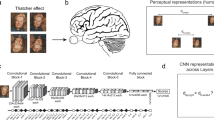Abstract
A self-organising neural network architecture for grey-scale visual object rcognition is presented. The network is composed of three processing layers with an architecture designed to give deformation tolerance. The processing layers involve feature extraction, sub-pattern detection and classification. Training is generally performed on-line in an unsupervised manner, classes being created when objects are presented that cannot be classified. The results given show the effect of the two discrimination parameters when the network is applied to two very different sets of images, namely hand written numerals and hand gestures images. The sensitivity of the network to the parameters that govern the size of detectable patterns and the areas over which they are detected is also tested. The robustness of the network to the order of image presentation is also demonstrated. The results show that parameter choice is not critical and heuristically chosen parameters provide near optimum performance.
Similar content being viewed by others
References
Li Y. Applications of moment invariants to neurocomputing for pattern recognition. Electr Lett 1991; 27(7): 587–588
Bailey RR, and Srinath M. Othagonal moment features for use with parametric and non-parametric classifiers. IEEE Trans Patt Anal Machine Intell 1996; 18(4): 389–399
Ferri M, Lombardini L, Pallotti C. Leukocyte classification by size functions. In: Proc Second IEEE Workshop on Applications of Computer Vision, IEEE Computer Society, December 1994
Cho K, Dunn SM. Learning shape classes. IEEE Trans Patt Anal Macine Intell 1994; 16(9): 882–888
Pal NR, Pal P, Basu AK. A new shape representation scheme and its application to shape discrimination using a neural network. Patt Recogn 1993; 26(4): 543–551
Fukushima K, Miyake S. Neocognitron: A new algorithm for pattern recognition tolerant of deformations and shifts in patterns. Patt Recogn1982; 15(6): 455–469
Yuceer C, Oflazer K. A rotation, scaling and translation invariant pattern classification system. Patt Recogn 1993; 26(5): 687–710
Himes GS, Inigo RM. Automatic target recognition using a neocognitron. IEEE Trans Knol Data Eng 1992; 4(2): 167–172
Minnix JI, McVey ES, Inigo RM. A multilayered self-organizing artificial neural network for invariant pattern recognition. IEEE Trans Knowl Dat Eng 1992; 4(2): 162–167
Bussain B, Kabuka MR. A novel feature recognition neural network and its application to character recognition. IEEE Trans Patt Anal Machine Intell 1994; 16(1): 98–106
Idan Y, Auger J-M. Pattern recognition by cooperating neural networks. SPIE Neural and Stochastic Methods in Image and Signal Processing 1992; 1766: 437–443
Fukushima K, Wake N. Handwritten alphanumeric character recognition by the neocognitron. IEEE Trans Neural Net 1991; 2(3): 355–365
Banarse DS, Duller AWG. Vision experiments with neural deformable template matching. University of Wales, Bangor, Internal Report, 1996
Masters T. Signal and Image Processing with Neural Networks. John Wiley & Sons, New York, 1994
Haykin S. Neural Networks — A Comprehensive Foundation. Macmillan, New York, 1994
Ting C, Chuang K-C. An adaptive alogithm for neocognitron to recognize analog images. Newurl Net 1993; 6: 285–299
Hussain B, Kabuka MR. Neural net transformation of arbitrary Boolean functions. In: SPIE 1992 Int Symposium on Optical and Applied Science: Neural and Stchastic Methods in Image and Signal Processing (Invited), July 1992
Gazula S, Kabuka MR. Design of supervised classifiers using boolean neural networks. IEEE Trans Patt Anal Machine Intell 1995; 17(12): 1239–1246
Banarse DS, Duller AWG. Deformation invariant pattern classification for recognising hand gestures. In: Proc 1996 IEEE Int Conf Neural Networks, IEEE Press, 1996; 1812–1816
Author information
Authors and Affiliations
Corresponding author
Rights and permissions
About this article
Cite this article
Banarse, D.S., Duller, A.W.G. Deformation invariant visual object recognition: Experiments with a self-organising neural architecture. Neural Comput & Applic 6, 79–90 (1997). https://doi.org/10.1007/BF01414005
Issue Date:
DOI: https://doi.org/10.1007/BF01414005




